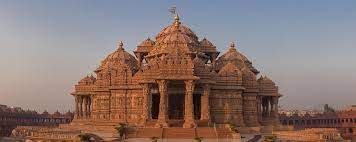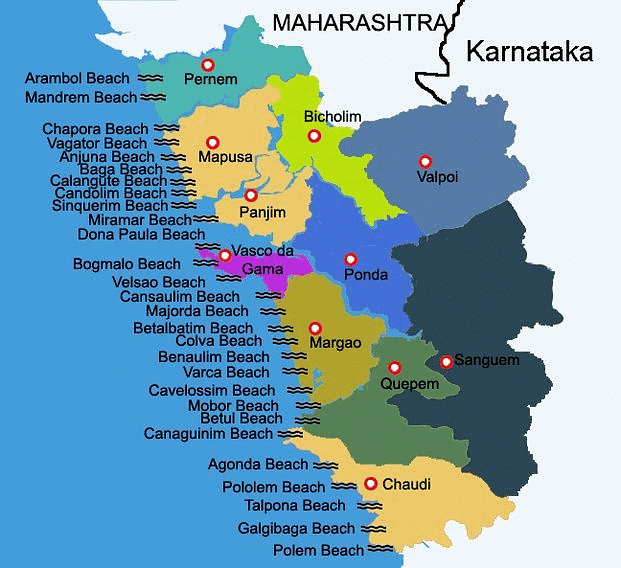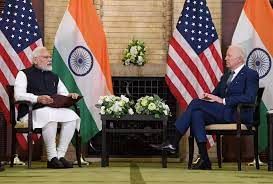UPSC Daily Current Affairs- 12th September 2023 | Current Affairs & Hindu Analysis: Daily, Weekly & Monthly PDF Download
Swaminarayan Akshardham temple
Subject: Art and Culture
Why in News?
UK Prime Minister Rishi Sunak and his wife Akshata Murty visited the Swaminarayan Akshardham temple recently.
About Swaminarayan Akshardham temple:-
- Opened in 2005.
- Location: New Delhi, India.
- Swaminarayan Akshardham is the world’s largest comprehensive Hindu temple.
- The temple was built to honor Bhagwan Swaminarayan (1781-1830), the founder of the Swaminarayan tradition.
- It is a fine example of architectural prowess that upholds the Hindu cultural legacy of thousands of years.
- It lies east of the Yamuna River.
Features:-
- The temple complex showcases stunning architecture inspired by ancient Vedic and Hindu architectural principles.
- The main monument is made of intricately carved pink sandstone and white marble.
- It stands 141 feet tall.
- It is 316 feet (96 meters) broad and 356 feet (109 meters) long.
- It features more than 20,000 statues and sculptures.
- The central monument represents Mount Meru, the mythical abode of the gods.
- The intricate carvings all over the interior and exterior walls depict various life forms.
- One of the most revered symbols of Hindu worship, the elephant, features prominently in the carvings.
- At the temple’s base are 148 life-size, perfectly sculpted elephants, weighing a total of 3000 tonnes.
- Another astounding fact is that the temple is not supported by steel or concrete.
- It houses a Musical Fountain (also known as the Yagnapurush Kund) which is India’s largest step well.
- The Akshardham Temple was inducted into the Guinness World Records in 2007 for being the world’s largest comprehensive Hindu Temple, attracting visitors from all over the world.
Source: Indian Express
Phanigiri artefacts
Subject: Art and Culture

Why in News?
The Phanigiri artefacts, belonging to 200 BCE-400 CE and discovered in 1942, are on display at New York Metropolitan Museum of Art, where they narrate an epoch-making change in the history of Buddhism
About Phanigiri artefacts:
- The Phanigiri Buddhist site is considered one of the most important finds in Buddhist iconography in this millennium.
- Phanigiri (meaning hillock of snake hood) is a small village in the state of Telangana.
- Key findings
- The thoranas discovered at Phanigiri are very important as they are among the first found south of Sanchi.
- The same thorana has a panel that shows both Mahayana and Hinayana school of thought.
- There is evidence from Phanigiri that shows the deification of Buddha, and we can date this change. From a historical and spiritual identity there is a transition to canonisation and ritual.
- The monograph of the event has the image of the Buddha, wearing what looks like a Roman toga with folds, carved in limestone.
Source: The Hindu
Drop in India's Reservoir Water Levels
Subject: Geography

Why in News?
India, a country heavily reliant on monsoon rains, faced a significant challenge in August 2023 with an unprecedented rainfall deficit.
- As a result, the water levels in the nation's crucial reservoirs have experienced a sharp decline, raising concerns about water supply for households, industries, and power generation.
- August is typically a month when India's reservoirs see their water storage levels increase significantly. However, August 2023 was an exception, as it marked the driest August in over 120 years. Instead of the expected 255 mm of rainfall, the country received only about 162 mm, resulting in a 36% rainfall deficiency.
How Dry are India’s Reservoirs?
- According to the Central Water Commission (CWC), the live storage in the 150 reservoirs was 113.417 billion cubic meters (BCM) as of 31st August, 2023, which was 63% of their total live storage capacity.
- This was about 23% less than the storage during the same period in 2022 and about 10% less than the average of the last 10 years.
- The water levels in the reservoirs varied across different regions and river basins. The southern region, which had a rainfall deficiency of 60% in August, had the lowest storage level of 49% of its combined capacity.
- The eastern region, which received normal rainfall, had the highest storage level of 82% of its combined capacity.
- Some of the river basins that had highly deficient or deficient water levels were:
- Highly Deficient:
- Pennar basin in Karnataka and Andhra Pradesh
- Mahanadi basin in Chhattisgarh and Odisha
- Deficient:
- Subarnarekha, Brahmani and Vaitarni basins in Jharkhand, West Bengal and Odisha
- Kaveri basin in Karnataka and Tamil Nadu
- Mahi basin in western India
- Krishna basin in Maharashtra, Karnataka and Telangana
- Water storage in the reservoirs of the eastern, western, central and southern regions, except the northern region is less than last year (2022).
What Are the Consequences of this Water Scarcity?
- Agriculture:
- The reservoirs provide irrigation water for crops, especially during the rabi season. The reduced water availability can affect crop production and farmers’ incomes.
- Power:
- The reservoirs also supply water for hydropower generation, which accounts for over 12% of India’s total electricity generation.
- The dry August led to an unexpected increase in power demand, primarily for irrigation purposes.
- Power generation reached a record high in August, necessitating additional electricity production by coal-fired power plants due to the precarious water levels in the reservoirs.
- Environment:
- The reservoirs also support biodiversity and ecosystem services, such as flood control, groundwater recharge, fisheries and recreation. The lower water levels can affect these functions and cause ecological damage.
- Impact on Water Supply:
- India's annual rainfall primarily occurs during the southwest monsoon season, making these reservoirs vital for water supply year-round. This scarcity in water storage threatens households.
What are the Causes for the Rainfall Deficit?
- El Niño:
- El Niño is a climatic phenomenon that occurs when the sea surface temperature in the central and eastern Pacific Ocean rises above normal.
- It affects the global weather patterns and reduces rainfall in India during the monsoon season.
- According to the India Meteorological Department (IMD), El Niño was present during August 2023 and was expected to continue till September.
- The IMD has forecasted that rainfall in September will likely not be more than 10% deficient.
- However, the looming threat of El Niño in the equatorial Pacific Ocean, which is still gaining strength, poses a significant risk to India's water resources.
- Indian Ocean Dipole (IOD):
- The Indian Ocean Dipole (IOD) is defined by the difference in sea surface temperature between two areas (or poles, hence a dipole) – a western pole in the Arabian Sea (western Indian Ocean) and an eastern pole in the eastern Indian Ocean south of Indonesia.
- The IOD affects the climate of Australia and other countries that surround the Indian Ocean Basin, and is a significant contributor to rainfall variability in this region.
- According to IMD, IOD was expected to turn favourable for the monsoon rainfall this year, but did not have much impact.
Way Forward
- Promote efficient water management practices in agriculture, including the adoption of drip irrigation and rainwater harvesting techniques.
- Encourage crop diversification and the cultivation of drought-resistant crops to reduce the reliance on water-intensive farming.
- Water innovation initiatives, such as desalination, wastewater treatment, smart water technologies, and climate-resilient agriculture, can help enhance water supply and efficiency and cope with water challenges and uncertainties.
- Invest in renewable energy sources like solar and wind power to reduce the dependency on hydropower generation, especially during dry periods.
- Raise awareness among the public about responsible water usage and the importance of conservation.
Source: The Hindu
India- USA Relations
Subject: International Relations
Why in News?
Recently the US President arrived in New Delhi to attend the G-20 Summit and met Prime Minister Narendra Modi for a bilateral meeting.
Highlights of the bilateral meeting:
- INDUS -X: The leaders commended the India-U.S. Defence Acceleration Ecosystem (INDUS-X) team for establishing a robust collaboration agenda to harness the innovative work of the U.S. and Indian defence sectors to address shared security challenges.
- UN Security Council seat: US reaffirmed support for a reformed UN Security Council with India as a permanent member.
- Initiative on Critical and Emerging Technology (iCET): Both the countries intend to undertake a midterm review of iCET in September 2023 to continue to drive momentum toward the next annual iCET review, co-led by the National Security Advisors of both countries, in early 2024.
- India-U.S. Global Challenges Institute: The leaders welcomed the signing of an MoU between Indian universities, represented by the Council of Indian Institutes of Technology (IIT Council), and the Association of American Universities (AAU) to establish the India-U.S. Global Challenges Institute.
- Technology Transfer: The leaders commenced of negotiations for a commercial agreement between GE Aerospace and Hindustan Aeronautical Limited (HAL) to manufacture GE F-414 jet engines in India.
About India- USA Relations:
Historical:
- During the Cold War, India pursued a non-aligned foreign policy and maintained a distance from both the US and the Soviet Union.
- In the early 1990s, India began to open up its markets to foreign investment, including from the US, and undertook significant economic reforms.
- This led to a gradual improvement in relations between the two countries.
- The two countries have also increased their defence ties, with the US becoming India’s second-largest arms supplier after Russia.
- In recent decades, India’s growing strategic importance as a counterweight to China has led to closer ties with the US, particularly in the security and defence domains.
Political:
- India has joined the US-led Indo-Pacific Economic Framework for Prosperity (IPEF).
- India-U.S. 2+2 Ministerial Dialogue: It is led by the heads of foreign and defence ministries of India and the U.S.
- Two successful rounds of this Dialogue have been held so far.
- India-U.S. Commercial Dialogue: The India-U.S. Commercial Dialogue is led by the Minister of Commerce and Industry (CIM) and the U.S. Secretary of Commerce.
- India – U.S. Economic and Financial Partnership: The India – U.S. Economic and Financial Partnership is led by the Finance Minister (FM) and the U.S. Secretary of the Treasury.
Trade and commerce:
- The U.S. has emerged as India’s biggest trading partner in 2022-23 on account of increasing economic ties between the two countries.
- The bilateral trade has increased by 7.65% to USD 128.55 in 2022-23 as against USD 119.5 billion in 2021-22.
- Exports to the U.S. rose by 2.81% to USD 78.31 billion in 2022-23 as against USD 76.18 billion in 2021-22, while imports grew by about 16% to USD 50.24 billion.
- In 2021-22, India had a trade surplus of USD 32.8 billion with the US.
- The U.S. is the largest destination for India’s merchandise exports, while it ranks as India’s third-largest merchandise import supplier, after China and the European Union.
Defence Cooperation:
- Both have strong defence cooperation, which is based on the “New Framework for India US Defence Cooperation” that was renewed in 2015 for a period of ten years.
- Several defence agreements have been signed, such as the Logistics Exchange Memorandum of Association in 2016, the Communications Compatibility and Security Agreement in 2018, the Industrial Security Agreement in 2019, and the Basic Exchange and Cooperation Agreement in 2020.
- The two countries conduct a number of bilateral military exercises such as Yudh Abhyaas and Vajra Prahari, and also participate in defence exchanges to deepen their military-to-military cooperation.
- In 2019, the two countries conducted a tri-services exercise called Tiger Triumph.
- Another grouping in the Middle East – I2U2 involving India, Israel, UAE and the US is being termed as the new Quad along with the existing QUAD
Education partnership:
- It is an important pillar of India-US ties and both the countries share strong linkages and history of higher education collaborations.
- The United States Educational Foundation in India (USEFI) was set up after a bilateral agreement on education exchange was signed between India and the US on February 2, 1950
Increased diaspora:
- The number of Indians and Indian Americans in the U.S. is estimated at around 4 million, which accounts for almost 1% of the total U.S. population.
- Indian diaspora in America over the years have increased. It has contributed to income creation in the USA through knowledge-based employment and also to Indian economic growth through remittance.
- Growing financial and political clout of the affluent Asian Indian diaspora is noteworthy.
Challenges associated with the relations:
- Trade: Recently India and US confronted each other regarding tariffs and protectionist policies.
- US has continuously accused India of high tariffs and India have accused USA of restriction to US markets and high tariffs on Indian products.
- Intellectual Property Rights: US has continuously criticised India for its IPR policies. It has accused India of acting against Intellectual properties of major companies especially pharmaceutical over generic drugs.
- Continuous support to Pakistan: Although US has reduced support to Pakistan, it has still provided monetary support to Pakistan.
- In February 2016, USA intended to provide Pakistan eight nuclear-capable F-16 fighters and assorted military goods.
- Relations with Russia: India is all time friend of Russia while USA is its all-time rivalry.
- In 2018, India inked the historic agreement with Russia to procure four S-400 surface-to-air missile defence system ignoring America’s CAATSA
- With she U.S. threatened India with sanctions over India’s decision.
- Relations with Iran: India has continuously bought oil from Iran despite of US sanctions on Iran.
- The United States threatened India with sanctions over India’s decision to buy oil from Iran.
- But recently it exempted India from sanctions that allowed India to buy oil from Iran.
Way Forward:
Therefore, it is in the mutual interest for both India and USA to rise above differences and ensure continuous cooperation to establish a peaceful, progressive and multilateral world. The partnership between India and US is simply one of the most consequential in the world.
Source: The Hindu
What is the ‘Goa Roadmap for Tourism’?
Subject: International Relations

Why in News?
In a unanimous decision, G20 leaders endorsed the significance of the ‘Goa Roadmap’ for tourism as a path towards achieving sustainable development goals (SDGs).
About ‘Goa Roadmap for Tourism’:
- The ‘Goa Roadmap’, an outcome of India’s G20 Tourism Track, is a blueprint for sustainable global tourism.
- It is aligned with the theme of India’s G20 Presidency, and underscores the role of tourism in society, the economy, and environmental efforts.
- The roadmap focuses on five interconnected priorities. They are,
- green tourism;
- digitization;
- destination management;
- skills development;
- support for tourism micro, small, and medium-sized enterprises (MSMEs);
- These priorities have been endorsed by all G20 countries, emphasizing their commitment to achieving sustainable, resilient, and inclusive tourism.
- India’s vision of ‘Travel for LiFE’ (Lifestyle for Environment) has been incorporated into the Goa roadmap.
G20 Tourism and SDG Dashboard:
- It was launched by the Union Ministry of Tourism, in collaboration with the United Nations World Tourism Organization (UNWTO).
- The dashboard will serve as a global repository, showcasing the best practices and case studies of sustainable tourism practices and policies from G20 nations.
Key Facts about Mission LiFE (Lifestyle for Environment):
- Mission LiFE, or Lifestyle for Environment, is an India-led global mass movement to nudge individual and community action to protect and preserve the environment.
- It was launched by the Indian Prime Minister at the 26th UN Climate Change Conference of the Parties (COP26) in Glasgow in November 2021.
- The program hopes to “mobilize one billion Indians as well as people in other countries to become individuals who practice sustainable lifestyles.
- It makes the fight against climate change democratic, in which everyone can contribute with their respective capacities.
- It emboldens the spirit of the P3 model, i.e. Pro Planet People.
- It functions on the basic principles of ‘Lifestyle of the planet, for the planet and by the planet’.
- It aims at following a three-pronged strategy for changing people's collective approach towards sustainability,
- nudging individuals to practice simple yet effective environment-friendly actions in their daily lives (demand)
- enabling industries and markets to respond swiftly to the changing demand (supply)
- to influence government and industrial policy to support both sustainable consumption and production (policy).
Source: Indian Express
Need for Fintech Self-Regulatory Organizations (SROs)
Subject: Economy

Why in News?
The Reserve Bank of India (RBI) Governor recently urged fintech entities to establish Self-Regulatory Organizations (SROs) in the rapidly evolving fintech sector,
About Fintech Self-Regulatory Organizations (SROs):
- Financial technology or Fintech refers to innovative technologies designed to enhance and automate the delivery of financial services.
- Fintech encompasses technological advancements across various financial sectors, including retail banking, investments, and decentralized cryptocurrencies like DeFi, with a focus on improving financial literacy and education.
- An SRO is a non-governmental entity responsible for creating and enforcing industry-specific rules and standards.
- SROs prioritize safeguarding consumer interests, promoting ethical conduct, ensuring equality, and nurturing professionalism.
- They collaborate with industry stakeholders to formulate and administer regulations.
Functions of a Self-Regulatory Organization (SRO):
- Acts as communication channel: SROs serve as a bridge between their member organizations and regulatory authorities such as the RBI.
- They facilitate communication, cooperation, and collaboration between industry participants and regulators.
- Establishing standards: One of the primary functions of an SRO is to set and enforce industry standards and minimum benchmarks.
- Standardization ensures consistency and fairness within the industry.
- Training and awareness: SROs are often responsible for providing training and awareness programs to their member organizations.
- This helps enhance the knowledge and skills of employees and industry professionals, ensuring that they stay up-to-date with industry best practices and regulatory requirements.
- Grievance redressal: When disputes or non-compliance issues arise among member organizations, these mechanisms help address and resolve such conflicts in a fair and efficient manner.
- This contributes to the smooth functioning of the industry and helps maintain trust among stakeholders.
Significance of SROs:
- Evolution of industry best practices: Fintech companies operate in a rapidly evolving landscape, and the industry needs to adapt and evolve its practices.
- The RBI recognizes the need for fintech’s to establish and follow industry best practices that align with the legal and regulatory framework of the country.
- This includes adhering to standards that ensure the responsible and ethical conduct of business.
- Preventing unethical selling: Mis-selling refers to the unethical or deceptive practices of selling financial products or services to customers.
- The RBI wants fintech’s to set standards that prevent mis-selling and ensure that products and services are marketed and sold transparently, without misleading or harming customers.
- Privacy protection norms: FinTech’s handle sensitive customer data, and data privacy and protection have become paramount concerns globally.
- RBI expects fintech companies to establish robust privacy and data protection norms that safeguard customer information and comply with the relevant data protection laws.
- Transparency of Pricing: Transparency in pricing is essential for consumers to make informed decisions.
- Fintech companies are expected to be transparent in their pricing structures, ensuring that customers have clear information about the costs and charges associated with the products or services they offer.
Concerns related to regulation of FinTech’s in India:
- Regulation: It is a major problem in the emerging world of FinTech, especially
- Due to the diversity of offerings in FinTech, it is difficult to formulate a single and comprehensive approach to these problems.
- In most countries, they are unregulated and have become fertile ground for scams and frauds.
- Uncertainty in the business: uncertainty in the FinTech sector is making things complicated for both FinTech service providers and consumers.
- The absence of an overarching regulatory framework for FinTech’s have created multiple points of ambiguity in the system for companies, investors and consumers.
- Unethical practices: Being away from the radar of the regulator, a number of unethical practices in lending have also been reported.
- Brutal collection methods, opaque lending practices, mis-selling of products, customer harassment, etc. are some of the instances.
Way Forward:
With the rising fintech sector in India, SROs emerge as indispensable entities, shaping industry behavior, promoting ethical conduct, and safeguarding consumer interests. Their role as industry experts and watchdogs helps create a more transparent, trustworthy, and well-regulated environment for all stakeholders.
Source: Indian Express
D.Ering Memorial Wildlife Sanctuary
Subject: Environment and Ecology
Why in News?
About D.Ering Wildlife Sanctuary:Two rescued wild animals, a Fishing Cat and a Python, were released in the D. Ering Wildlife Sanctuary in Arunachal Pradesh‘s East Siang district on Saturday. The animals were rescued by Kennedy Perme from Namsing Village and Len Tayeng from Borguli Village.
- Location: It is a protected area located in the East Siang district of Arunachal Pradesh.
- This sanctuary was established in the year 1977 and covers an area of around 190 square kilometers.
- It is named after the pioneer of modern Arunachal, late Daying Ering, who was a famed Indian politician.
- Vegetation: It is located in a unique ecosystem that comprises tropical evergreen, semi-evergreen, and deciduous forests.
- It is also home to the Siang River, which is one of the major rivers in Arunachal Pradesh.
- Streams and channels intersect the whole Sanctuary. There are small to medium waterbodies in the Sanctuary that provide good nesting sites for birds.
- Flora:
- About 80% of the Sanctuary is covered with grassland, and the rest is riverine forest patches with mixed bamboo and secondary forests.
- The main grass species are Saccharum spontaneum, S. arundinaceum, Neyraudia rennaudiana.
- Fauna:
- It is home to buffalo, elephant, tiger, leopard cat, barking deer, civet cat, sambar, jackal etc.
- The migratory birds like cranes, wild ducks, storks, waterfowls from Siberia and Mongolia can be spotted every year.
Source: The Hindu
|
59 videos|5388 docs|1140 tests
|






















